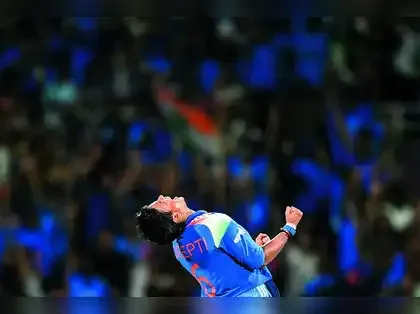It was meant to be. The hour had come, and as though summoned by destiny, they each rose, larger than life, making a moment, or passage of time, their own. The Indian women's cricket team had waited too long for their time in the sun. But who can rush these things?
When Harmanpreet Kaur held the World Cup aloft in Mumbai on Sunday - an Indian woman doing so for the first time - she didn't do so alone.
Shafali Verma, only 21, was dropped from the World Cup squad, but came into the picture before the semifinal when Pratika Rawal was injured. Shafali, playing for Haryana in Surat, stepped into the breach, made 87, her highest ODI score, and picked up two crucial wickets, comfortably taking the Player of the Match award. In 30 previous ODIs, she had only one wicket. 'I saw Shafali standing there. I knew today was her day,' said Harmanpreet on her inspired decision to toss the bowl to her eventual ace.
Jemimah Rodrigues was dropped early in a tournament in which India lost to Australia, England and South Africa in the league stage. In the semifinal, she made an unbeaten 127, restoring her team's self-belief and giving them a shot at the title.
Deepti Sharma knows what World Cup heartbreak feels like. In 2017, in the final against England, she was the second-last wicket to fall as India came agonisingly close, losing by 9 runs. In 2022, in Christchurch, South Africa needed 3 from 2 balls when Deepti had Mignon du Preez caught in the deep, only to see the umpire signal a no-ball. In 2025, Deepti made a run-a-ball 58 and picked up 5 for 34.
These are the names that ring out loudest now. But successful campaigns are not built on individuals. At different times, there was enough depth in this Indian squad to solve the problem immediately in front of them.
It was destined. Not blind luck, as in a man buying a lottery ticket for a lark and hitting the jackpot. But in that, India's women rising to the top of the cricket world was an idea whose time had come.
Ghuwara, Mohali, Hyderabad, Siliguri, Kadapa, Baroda, Chandigarh, Dehradun, Rohtak, Sangli, Moga, Agra, Delhi. These are the towns and cities that India's World Cup-winning team came from. Has the concept of India - its diversity, breadth, richness and strength - ever been more fairly represented?
Each of these players defied odds. Shafali cut her hair short so she could pass off as one of the boys and get into a coaching camp. Jemimah was the lone girl at her club when she made people sit up and take notice. Amanjot Kaur's first bat was crafted by her father in the small carpentry workshop he runs.
Behind every successful woman in this Indian team is a story of struggle, sacrifice and hard work with little or no promise of reward.
This story is not new. Stalwarts such as Shantha Rangaswamy, Diana Edulji, Shubhangi Kulkarni and Sudha Shah were constantly out of pocket representing their country. More recently, Anjum Chopra, Jhulan Goswami and Mithali Raj received stepsisterly treatment, playing on grounds that were not needed for the men, in front of empty stands in non-televised games. It's no wonder the winning team had the grace to stop and share the trophy with that trio doing broadcasting duties when the hour came.
Women's cricket has had it better in recent times, with central contracts, equal match fees, professional support staff, a better domestic competition and international franchise leagues. But given that they played their first World Cup in 1973, 2 yrs before the men, it has been a long time coming.
While credit has been given to those in power - and they're all men, not that much has changed yet - it would not be wrong to say that this team succeeded despite the system, and not because of it. In that sense, this is a victory whose true value can only be felt by the women of India. They live the daily struggle for equity: in homes and workplaces, on streets and public transport, and everywhere in between.
What happened in Navi Mumbai was the culmination of decades of women having to fight, ask, coax and cajole their way to getting what was rightfully theirs all along. In that sense, it was the timing that was written in the stars. 'Whatever is destined not to happen will not happen, try as you may,' said Ramana Maharshi. And this was the story of all those who came before the class of 2025. 'Whatever is destined to happen will happen, do what you may to prevent it. This is certain,' he said, as if speaking to Harmanpreet and her team. 'The best course, therefore, is to remain silent.'
Women have not had the privilege of being silent. But if this win teaches us one thing, it might be best for men to simply get out of the way and let the women chart the future. It promises to be a bright one. And, what's more, it's destined.
When Harmanpreet Kaur held the World Cup aloft in Mumbai on Sunday - an Indian woman doing so for the first time - she didn't do so alone.
Shafali Verma, only 21, was dropped from the World Cup squad, but came into the picture before the semifinal when Pratika Rawal was injured. Shafali, playing for Haryana in Surat, stepped into the breach, made 87, her highest ODI score, and picked up two crucial wickets, comfortably taking the Player of the Match award. In 30 previous ODIs, she had only one wicket. 'I saw Shafali standing there. I knew today was her day,' said Harmanpreet on her inspired decision to toss the bowl to her eventual ace.
Jemimah Rodrigues was dropped early in a tournament in which India lost to Australia, England and South Africa in the league stage. In the semifinal, she made an unbeaten 127, restoring her team's self-belief and giving them a shot at the title.
Deepti Sharma knows what World Cup heartbreak feels like. In 2017, in the final against England, she was the second-last wicket to fall as India came agonisingly close, losing by 9 runs. In 2022, in Christchurch, South Africa needed 3 from 2 balls when Deepti had Mignon du Preez caught in the deep, only to see the umpire signal a no-ball. In 2025, Deepti made a run-a-ball 58 and picked up 5 for 34.
These are the names that ring out loudest now. But successful campaigns are not built on individuals. At different times, there was enough depth in this Indian squad to solve the problem immediately in front of them.
It was destined. Not blind luck, as in a man buying a lottery ticket for a lark and hitting the jackpot. But in that, India's women rising to the top of the cricket world was an idea whose time had come.
Ghuwara, Mohali, Hyderabad, Siliguri, Kadapa, Baroda, Chandigarh, Dehradun, Rohtak, Sangli, Moga, Agra, Delhi. These are the towns and cities that India's World Cup-winning team came from. Has the concept of India - its diversity, breadth, richness and strength - ever been more fairly represented?
Each of these players defied odds. Shafali cut her hair short so she could pass off as one of the boys and get into a coaching camp. Jemimah was the lone girl at her club when she made people sit up and take notice. Amanjot Kaur's first bat was crafted by her father in the small carpentry workshop he runs.
Behind every successful woman in this Indian team is a story of struggle, sacrifice and hard work with little or no promise of reward.
This story is not new. Stalwarts such as Shantha Rangaswamy, Diana Edulji, Shubhangi Kulkarni and Sudha Shah were constantly out of pocket representing their country. More recently, Anjum Chopra, Jhulan Goswami and Mithali Raj received stepsisterly treatment, playing on grounds that were not needed for the men, in front of empty stands in non-televised games. It's no wonder the winning team had the grace to stop and share the trophy with that trio doing broadcasting duties when the hour came.
Women's cricket has had it better in recent times, with central contracts, equal match fees, professional support staff, a better domestic competition and international franchise leagues. But given that they played their first World Cup in 1973, 2 yrs before the men, it has been a long time coming.
While credit has been given to those in power - and they're all men, not that much has changed yet - it would not be wrong to say that this team succeeded despite the system, and not because of it. In that sense, this is a victory whose true value can only be felt by the women of India. They live the daily struggle for equity: in homes and workplaces, on streets and public transport, and everywhere in between.
What happened in Navi Mumbai was the culmination of decades of women having to fight, ask, coax and cajole their way to getting what was rightfully theirs all along. In that sense, it was the timing that was written in the stars. 'Whatever is destined not to happen will not happen, try as you may,' said Ramana Maharshi. And this was the story of all those who came before the class of 2025. 'Whatever is destined to happen will happen, do what you may to prevent it. This is certain,' he said, as if speaking to Harmanpreet and her team. 'The best course, therefore, is to remain silent.'
Women have not had the privilege of being silent. But if this win teaches us one thing, it might be best for men to simply get out of the way and let the women chart the future. It promises to be a bright one. And, what's more, it's destined.
(Disclaimer: The opinions expressed in this column are that of the writer. The facts and opinions expressed here do not reflect the views of www.economictimes.com.)









ANAND VASU
The writer is former joint editor-in-chief, Wisden India